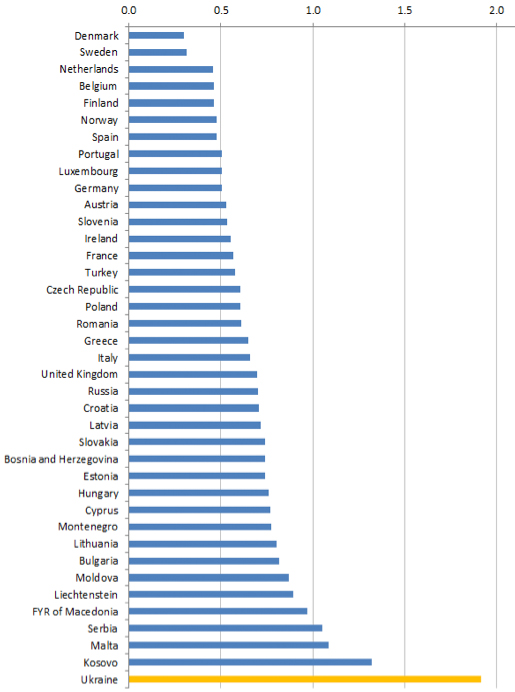What’s Wrong With the 'Rotterdam Formula'?
Last week the Rada Committee on Fuel and Energy organized hearings on the newly introduced formula for calculating the coal price, which is nicknamed ‘Rotterdam + delivery’. Let us remind what this formula is, how did it appear and how does it affect the life of an ordinary Ukrainian.
In March 2016 the National Commission for State Regulation of Energy and Public Utilities (NCSREPU) approved a new methodology for calculating the wholesale market price for the electric energy.
It is the price which heat and electricity generating power stations based on coal use when selling their electric energy to the market. It dedicates particular attention to the price of coal.
According to the new methodology, the price of the coal used to produce heat and electricity is calculated in this way: "coal price in the port of Rotterdam plus the price of delivery to Ukraine."
The new formula means that all customers now have to pay an increased electrical energy tariff because of the higher "Rotterdam" price of the coal.
The proposed changes caused an animated discussion among experts. Why do we use Rotterdam? How is the new formula related to the Ukrainian market? Representatives of the NCSREPU tried explaining this last week at the session of the Rada Energy Committee.
The Head of NCSREPU Dmytro Vovk presented explanation of the new formula. Below I will analyze certain statements by Dmytro, which I consider erroneous or consciously manipulative.
1. "The coal industry was insufficiently financed because the price of coal in Ukraine was substantially lower compared to that it in Rotterdam"
So should the price of sugar, coffee and cocoa be the same in Ukraine and in Cuba? Or should the price of oil or wheat grain be the same in Ukraine and UAE?
If Big-Macs in Ukrainian McDonalds are cheaper than in Swiss McDonalds — are they ‘underfinanced’ and should get state subsidies? Dmytro measures ‘underfinanced’ status by referring to Rotterdam, which has no coal mines. The correct comparison would be Columbia, Poland or Russia, where the coal price is substantially lower.
However, even if we admit such a comparison, it does not include state subsidies to the coal industry, which total $13 billion within the last 12 years. Who prevented the ‘underfinanced’ coal industry from ‘refinancing’ itself by simply setting the higher prices for coal and exporting it?
Another problem is that most of our coal is environmentally unsafe (it contains 2—3% sulfur) and that is why it is banned in Europe (where maximum sulfur content must be less than 1%). So now this coal is going to be included into the updated energy tariff in Ukraine.
2. "A coal mining rent should be introduced"
This contradicts the previous argument of the NCSREPU. If there is ‘lack of financing’, then should we introduce a rent which is a huge financial burden for the industry? Introducing mining rent in Ukraine will be inefficient because of the physical limitations of the Ukrainian coal industry.
Mining rent is a feasible solution in the case of open mining method and low mining expenses ($8—10 for coal and $20 for ore). Are there good reasons to introduce coal rent for mines, producing coal from under 500—1000 meters of soil with mining expenses of $30—60?
It is also impossible to effectively administer mining rent within the temporarily occupied territories of Donetska and Luhanska Oblasts. Do we really want to increase the pricing gap between Ukrainian and ‘occupied’ coal?
Finally, it is not within the competence or authority of the NCSREPU to determine whether there should or should not be a mining rent. The Cabinet of Ministers and the Rada can have a different view on the mining rent. So far, the Ukrainian budget included state subsidies, not the mining rent for the coal industry. If the regulating agency decided to introduce the rent — they should figure out the position of the Rada and the Cabinet before, not after, the new formulas are introduced.
I am sure that there will be no mining rent on coal in Ukraine.
3. "Ukraine lacks up to 40% of grade A coal requirements"
There is no need to import coal to Ukraine in 2016. This was stated by ex- Minister of Energy Volodymyr Demchyshyn and the current Energy Minister Ihor Nasalyk. There no import of coal in Ukraine’s forecast balance for 2016.
Grade A coal is not imported, it is transported from the temporarily occupied territories of the ATO zone. This coal is available and Ukrainian officials know that. It is a consumer fraud: to collect money for buying expensive and high quality imported coal, but to buy environmentally detrimental ‘occupied’ coal.
4. "The marginal price of the coal is ₴1,200 per ton (it used to be ₴1,100). Therefore, the influence of the new formula on the coal price is almost negligible"
Not, it is not so negligible. The end user tariff is what matters to both: the customer and the utility provider. In Spring 2015 the tariff on the electricity generated from coal was ₴.80, while in March 2016 it rose to ₴1.06 and in April 2016 — to ₴1.2, which is 33—50% more. And customers started paying more as well.
The changes are evident but the formula did not yet start working on the full scale. As soon as it does — the tariffs will be even higher.
Forecasted wholesale price on electric energy in Ukraine, ₴/MW-h excluding VAT
 |
| Source: NCSREPU |
5. "The formula is transparent now, officials cannot influence the price with their subjectivism"
No, they can. The formula includes variables that are determined by officials. Even the mere fact that the formula hasn’t yet started ‘working on a full scale’ confirms that it can be working ‘better’ or ‘worse’ — depending on the whims of officials.
For example the law requires that the ‘green’ tariff be indexed according to the exchange rate of the euro. DTEK Windpower got this indexation while Active Solar haven’t. What was the basis for this decision still remains unknown, while the law should be the same for everyone.
6. "Coal is like natural gas"
|
Natural Gas |
Coal |
|
Imported throughout the modern history of Ukraine |
Mostly not imported. There were separate instances of import for various reasons not related to the economy |
|
Not produced in the ATO zone |
Produced primarily in the ATO zone |
|
Higher piping rent was introduced first, then the price was increased |
The price was increased, yet there is no rent |
|
There is no monopoly |
One player controlling 80% of upstream and 70% of downstream |
|
Ukraine is actively protecting itself from a monopolist (Russian Gazprom) |
The largest coal producer (DTEK) is threatening to stop production and the state does nothing |
|
Price is subsidized by the state budget |
Price for individual consumption of electric energy produced from coal is subsidized by expensive electricity for business |
|
New post-Maidan management with transparent procurement procedures |
Outdated management with the state-owned enterprises of the Yanukovych era. Non-transparent tenders or procurement without tenders |
Coal is not like natural gas.
7. "No coal comes from the ATO zone since June 2016. There might be shortages and blackouts"
The same argument was used a year ago when the tariff was ₴.80. It is still valid now, when the tariff is ₴1.1. It looks like this is a permanent argument that works well in any situation.
If problems with logistics are an argument for increasing the tariff, then how does such increase work? Terrorists will get more money from the increased tariff and will then start letting the trains with coal pass?
In March — April — May 2016 the tariff for electric generation was ₴1.06 — ₴1.2 — ₴1.08. This allowed buying coal for $55 — 60. The price of the coal from a port in Turkey was $50 — 52, yet there was no import. Therefore, the increase of tariffs is not aimed at diversifying the supplies and creating reserve stocks. They just want to have a nice tariff and continue buying cheap Ukrainian coal.
8. "The regulator supports market reform and wants to eliminate cross-subsidies"
By increasing the tariffs for business the regulator increases cross-subsidies. Currently Ukraine has the highest individual/business electricity tariff discrepancy in Europe: our individual tariffs are two times less than the tariffs for the businesses.
Individual/business tariff ratios for electricity in Europe
 |
| Source: Eurostat |
It is impossible to perform market reform having such a huge tariff discrepancy. Therefore, there will be no market instruments for competing on price and quality.
9. "We might need to export coal in the future"
Markets do not believe in the ‘possible future’. All goods have export and import potential and any industry can use this argument. Nevertheless, Ukrenergo acquired Ukrainian electricity transforming stations with a 40% discount from the international market price.
10. "The new tariffs were introduced in a transparent manner and according to all the necessary procedures"
The new tariff was introduced in violation of the timeframes established by the rules of procedure. While the new formula was introduced on April 26, 2016, no actual calculations were presented up to this date, even after public promises were made by the management of the NCSREPU at the session of the Rada Energy Committee.
Therefore, the presentation of the new formula for calculating the retail price of the electricity generated by burning coal contains many discrepancies and some of its arguments are lacking any logic. The ‘Rotterdam + delivery’ formula is not supported by factual evidence. Taking the quality of our coal into account, its price should not be higher than Polish coal, which is 5—10% cheaper than Rotterdam (without delivery).
A column serves to express the personal opinion of the author. It does not aim to be objective or comprehensive about the topic in question. The opinion of Ukrayinska Pravda editors may differ from that of the author. The editors are not responsible for the factual accuracy and interpretation of the information, our media outlet hereby only serves as a platform.






